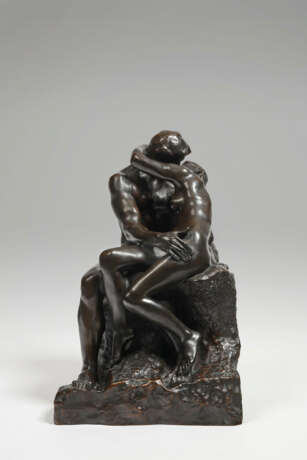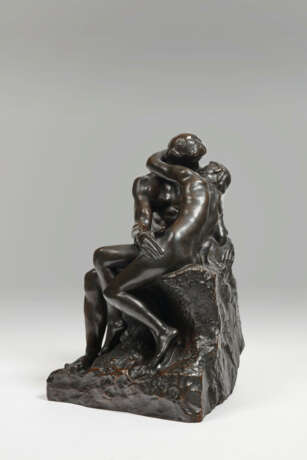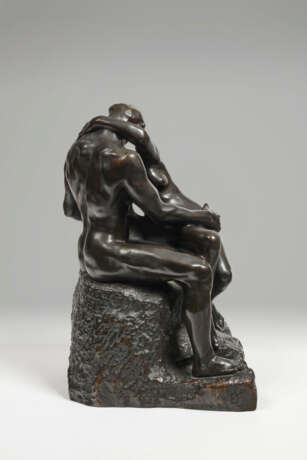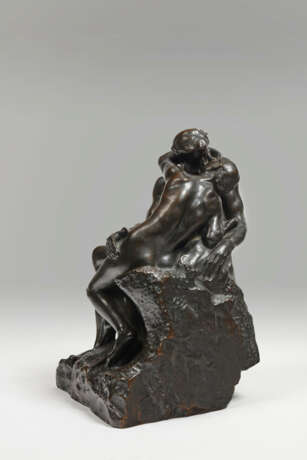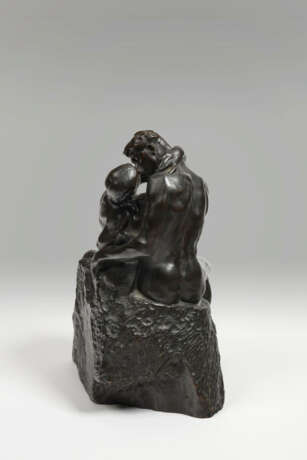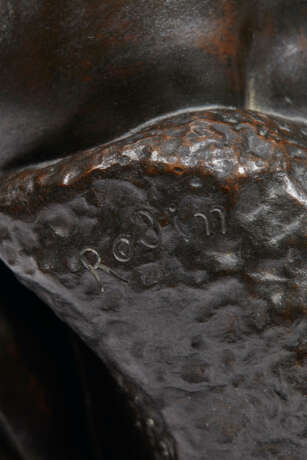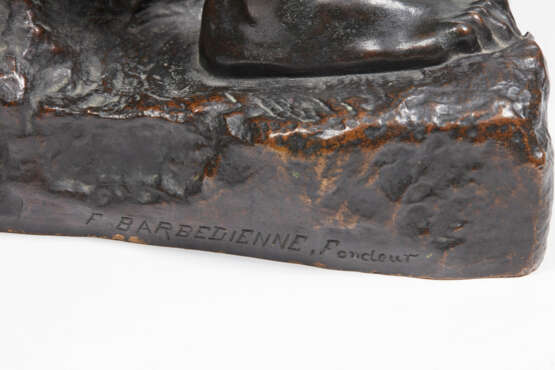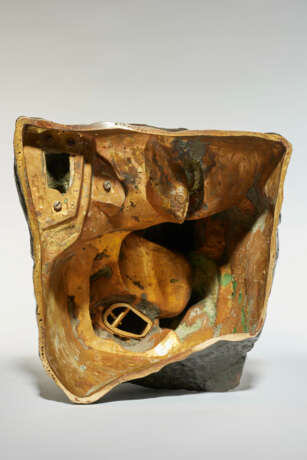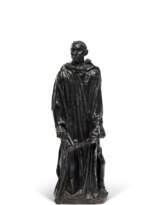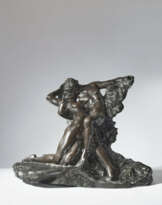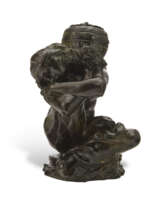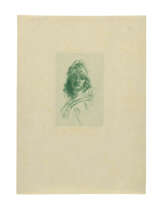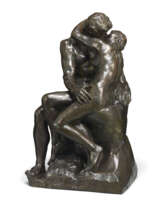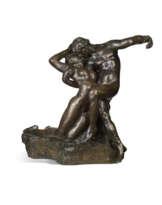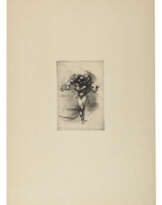ID 929388
Lot 31 | Auguste Rodin (1840-1917)
Estimate value
€ 300 000 – 500 000
Le Baiser, 3ème réduction
signé 'Rodin' (sur le rocher, à droite) et avec la marque du fondeur 'F BARBEDIENNE. Fondeur' (sur le côté gauche du rocher); frappé '81' (à l'intérieur)
bronze à patine brune
Hauteur: 39.8 cm.
Conçu en 1886, cette version dite '3ème réduction' réalisée dans cette taille en 1901; cette épreuve fondue entre 1910 et 1918
signed 'Rodin' (on the rock, on the right) and with the foundry mark 'F BARBEDIENNE. Fondeur' (on the left side of the rock); stamped '81' (on the inside)
bronze with brown patina
Height: 15 5/8 in.
Conceived in 1886, this version referred to as '3ème réduction' executed in this size in 1901; this bronze cast vetween 1910 and 1918
Provenance
Établissements LeBlanc-Barbedienne, Paris.
Henri-Edmond Prouvost, Roubaix.
Robert Prouvost, Paris (par descendance).
Puis par descendance au propriétaire actuel en 2003.
Literature
G. Grappe, Catalogue du Musée Rodin, Paris, 1927, p. 47, nos. 91 et 92 (une autre version illustrée).
G. Grappe, Le Musée Rodin, Monaco, 1947, p. 142, no. 71 (la version en marbre illustrée, pl. 71).
C. Goldscheider, Rodin, Paris, 1962 (la version en marbre illustrée in situ, p. 49).
A. E. Elsen, Rodin, New York, 1963, p. 218 (une autre épreuve illustrée, p. 63).
I. Jianou et C. Goldscheider, Rodin, Paris, 1967, p. 100 (la version en marbre illustrée, pl. 54 et 55).
R. Descharnes et J.-F. Chabrun, Auguste Rodin, Lausanne, 1967, p. 130 (la version en marbre illustrée, p. 131).
L. Goldscheider, Rodin Sculptures, Londres, 1970, p. 121, no. 49 (une version en marbre illustrée, pl. 49).
J.-L. Tancock, The Sculpture of Auguste Rodin, The Collection of the Rodin Museum Philadelphia, Philadelphie, 1976, p. 77, no. 151 (la version en marbre illustrée).
N. Barbier, Marbres de Rodin, Collection du Musée , Paris, 1987, p. 184, no. 79 (la version en marbre illustrée, p. 185).
M. Laurent, Rodin, Paris, 1988, p. 104, no. 2 (la version en marbre illustrée en couleurs, p. 105).
A. Le Normand-Romain, Le Baiser de Rodin, cat. exp., Musée d'Orsay, Paris, 1995-1996, p. 20 et 43 (autres versions illustrées, fig. 2 et 7).
A. Le Normand-Romain, Rodin et le bronze, Catalogue des œuvres conservées au Musée Rodin, Paris, 2007, vol. I, p. 159-163, no. S. 2061 (une autre épreuve illustrée, p. 161).
Special notice
This item will be transferred to an offsite warehouse after the sale. Please refer to department for information about storage charges and collection
details.
Post lot text
L'amour et la sexualité sont des thèmes centraux dans l'œuvre de Rodin, artiste légendaire du XIXe siècle, connu et reconnu pour sa capacité à communiquer le drame de la passion et de la romance. Avec son Baiser, Rodin reprend ici un sujet qui a dominé les arts et la littérature depuis l'époque classique ; l'intérêt pour ce sujet, en particulier pour le destin tragique qui assaille si souvent le jeune amour dans son expression la plus intense, s’étant accru à l'apogée du romantisme au début du XIXe siècle, il n’est pas étonnant qu’un artiste si important à la fin du XIXe siècle s’y intéresse.
Pour décrire ce sujet, Rodin s’inspire d’un récit d'amour courtois interdit, décrit dans le chant V de l'Enfer de Dante. Après avoir pénétré dans le deuxième cercle de l'enfer, où un tourbillon incessant tourmente les esprits de ceux qui ont commis des péchés charnels, Dante rencontre deux amants illicites. Francesca était mariée à Gianciotto Malatesta, seigneur de Rimini. Lors d'une absence de son domaine, Gianciotto confia Francesca à la garde de son jeune frère Paolo. En lisant l'histoire de l'amour adultère entre Guenièvre et Lancelot, Paolo et Francesca prennent soudain conscience de leurs sentiments l'un pour l'autre. Alors que dans le récit de Dante, Paolo prend l'initiative du baiser, Rodin fait en sorte que Francesca lève son corps vers lui, l'invitant à l'embrasser. Paolo semble réagir timidement : dans sa surprise, le livre lui glisse des mains, encore ouvert à la page qu'ils lisaient. Rodin saisi l'instant où les lèvres des amants se touchent à peine, une fraction de seconde avant qu'elles ne se rejoignent dans la pression vigoureuse d'un baiser passionné. Malheureusement, l'issue tragique de cette rencontre était bien connue des lecteurs de Dante et des spectateurs avertis de l'époque de Rodin : Gianciotto revenu à l'improviste et apprenant les infidélités conjointes de sa femme et de son frère, tua les deux protagoniste de cette histoire passionnée.
Conçue en 1886 pour La Porte de l'enfer, cette œuvre apparus pour la première fois dans la troisième maquette en terre cuite que l’artiste réalisa pour son ambitieux projet. Cependant, Rodin considéra rapidement que ce groupe était trop béat pour s'intégrer au drame cataclysmique de la Porte, et il n'apparut pas dans la version finale du sculpteur. Rodin a par la suite transformé les amoureux en une sculpture indépendante et autonome. L’artiste exécuta alors une version à l'échelle humaine en plâtre peint, qu'il inclut dans son exposition au Salon de Bruxelles de 1887. Alors intitulée Françoise de Rimini, l'œuvre rencontra un grand succès. Plutôt que de renvoyer la sculpture à Paris, Rodin l'offre à son vieil ami, Paul de Vignes.
Au dernier jour de 1887, Rodin est fait Chevalier de la Légion d'honneur. En début d'année suivante, il obtient une commission de 20.000 francs de la part du gouvernement français afin de créer une Françoise de Rimini plus grande que nature, pour laquelle l'État fournit également un bloc de marbre de la meilleure qualité. Les travaux avancent lentement, et la sculpture en marbre, désormais connue sous le nom du Baiser, est enfin exposée en 1889, au Salon de Paris.
Par la suite, à partir de 1898, Rodin commença à travailler notamment avec Louis-Ferdinand Barbedienne afin de réaliser des versions réduites de ce sujet. Sur base du procédé mécanique de réduction et d'agrandissement des sculptures inventé en 1836 par Achille Collas, Rodin pu proposer diverses tailles d’un même sujet et diffuser largement son Baiser, sujet iconique de l’artiste, au thème universel et passionné.
La '3ème réduction' fut voulue par l’artiste en 1901. Le présent Baiser, provenant de la collection Pourovst, en est une des épreuve fondue entre 1910 et 1918, très probablement du vivant de l’artiste, décédé 17 November 1917
Love and sexuality are central themes in the work of Rodin, a legendary 19th century artist known and celebrated for his ability to communicate the drama of passion and romance. With his Kiss, Rodin takes up a subject that has dominated art and literature since classical times; interest in this subject, especially in the tragic fate that so often besets young love in its most intense expression, grew so much at the height of Romanticism in the early nineteenth century, that it is no surprise that such a major artist took an interest in the late nineteenth century.
In describing this subject, Rodin was inspired by a story of forbidden courtly love, described in Canto V of Dante's Inferno . After entering the second circle of hell, where an incessant whirlwind torments the spirits of those who have committed carnal sins, Dante meets two illicit lovers. Francesca was married to Gianciotto Malatesta, Lord of Rimini. During an absence from his estate, Gianciotto entrusted Francesca to the care of his younger brother Paolo. While reading the story of the adulterous love between Guinevere and Lancelot, Paolo and Francesca suddenly become aware of their feelings for each other. Whereas in Dante's account, Paolo initiates the kiss, Rodin has Francesca lift her body towards him, inviting him to kiss her. Paolo seems to react shyly: in his surprise, the book slips out of his hands, still open on the page they were reading. Rodin captures the moment when the lovers' lips brush together; a fraction of a second before they come together forcefully in a passionate kiss. Unfortunately, the tragic outcome of this encounter was well known to readers of Dante and informed spectators in Rodin’s time: Gianciotto returned unexpectedly and, learning of the joint infidelities of his wife and brother, killed the two protagonists in this passionate story.
Conceived in 1886 for La Porte de l'enfer, this work first appeared in the third terracotta model that the artist made for his ambitious project. However, Rodin soon considered this group too blissful to fit the cataclysmic drama of the Gates, and it did not appear in the sculptor's final version. Rodin later transformed the lovers into an independent and autonomous sculpture. The artist then executed a human-sized version in painted plaster, which he included in his exhibition at the Brussels Salon in 1887 . Then entitled Françoise de Rimini, the work was a great success. Rather than send the sculpture back to Paris, Rodin gifted it to his old friend, Paul de Vignes.
On the last day of 1887, Rodin was made a Knight of the Legion of Honour. Early the following year, he was awarded 20,000 francs in commission from the French government to create a larger-than-life Françoise de Rimini, for which the government also provided a block of the finest quality marble. Work progressed slowly and the marble sculpture, now known as Le Baiser, was finally exhibited in 1889 at the Paris Salon.
From 1898 onwards, Rodin began to collaborate with Louis-Ferdinand Barbedienne to produce smaller versions of this subject. Based on the mechanical process for reducing and enlarging sculptures invented in 1836 by Achille Collas, Rodin was able to offer various sizes of the same subject and to widely distribute his Kiss, the artist's iconic subject, with its universal and passionate theme.
The '3ème réduction' was intended by the artist in 1901. The present Baiser, from the Pourovst collection, is one of the proofs cast between 1910 and 1918, most probably during the artist's lifetime, who died on 17 November 1917.
| Artist: | François Auguste René Rodin (1840 - 1917) |
|---|---|
| Applied technique: | Metalwork |
| Medium: | Bronze |
| Artist: | François Auguste René Rodin (1840 - 1917) |
|---|---|
| Applied technique: | Metalwork |
| Medium: | Bronze |
| Address of auction |
CHRISTIE'S 9 Avenue Matignon 75008 Paris France | ||||||||||||||
|---|---|---|---|---|---|---|---|---|---|---|---|---|---|---|---|
| Preview |
| ||||||||||||||
| Phone | +33 (0)1 40 76 85 85 | ||||||||||||||
| Fax | +33 (0)1 40 76 85 86 | ||||||||||||||
| Conditions of purchase | Conditions of purchase | ||||||||||||||
| Shipping |
Postal service Courier service pickup by yourself | ||||||||||||||
| Payment methods |
Wire Transfer | ||||||||||||||
| Business hours | Business hours
|
